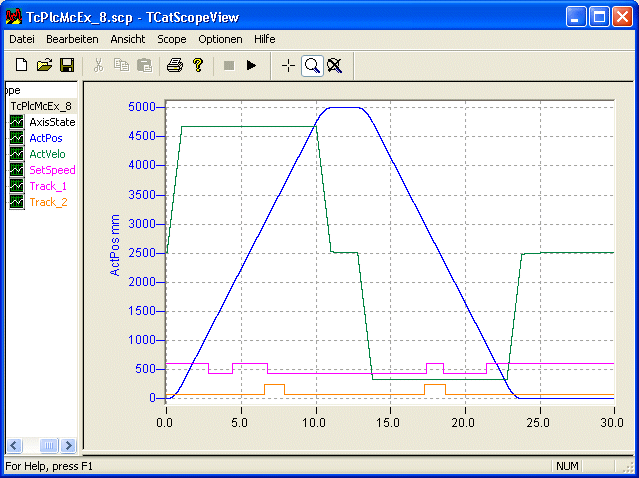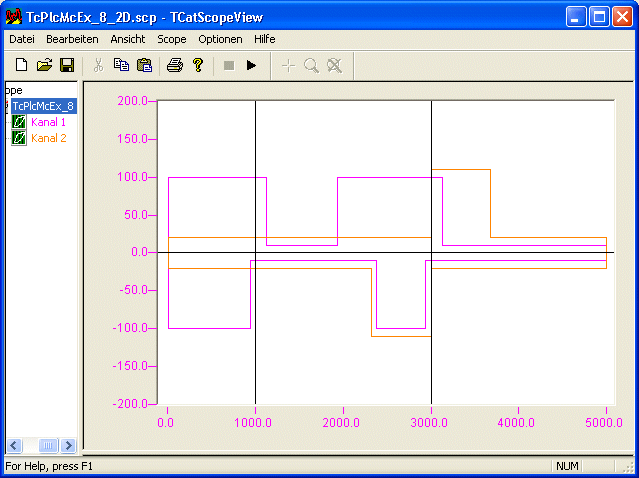MC_DigitalCamSwitch_BkPlcMc
 | Available from version 3.0 |
The function block generates software cams depending on the position, direction of travel and velocity of an axis.
 Inputs
Inputs
VAR_INPUT
Enable: BOOL;
EnableMask: DWORD;
END_VARName | Type | Description |
|---|---|---|
Enable | BOOL | This input controls all activities of the function block. |
EnableMask | DWORD | A mask with bits that specify the activation of the outputs in Outputs. |
 Inputs/outputs
Inputs/outputs
VAR_IN_OUT
Axis: AXIS_REF_BkPlcMc;
Switches: CAMSWITCH_REF_BkPlcMc;
Outputs: OUTPUT_REF_BkPlcMc;
TrackOptions: TRACK_REF_BkPlcMc;
END_VARName | Type | Description |
|---|---|---|
Axis | AXIS_REF_BkPlcMc | Here, the address of a variable of type AXIS_REF_BkPlcMc should be transferred. |
Switches | CAMSWITCH_REF_BkPlcMc | Here, an array of type CAMSWITCH_REF_BkPlcMc should be transferred. |
Outputs | OUTPUT_REF_BkPlcMc | Here, the address of a variable of type OUTPUT_REF_BkPlcMc should be transferred. |
TrackOptions | TRACK_REF_BkPlcMc | Here, an array of type TRACK_REF_BkPlcMc should be transferred. |
 Outputs
Outputs
VAR_OUTPUT
InOperation: BOOL;
Busy: BOOL;
Error: BOOL;
ErrorID: UDINT;
END_VARName | Type | Description |
|---|---|---|
InOperation | BOOL | This indicates whether the function block is active. |
Busy | BOOL | This output is TRUE while the command is being processed. |
Error | BOOL | The occurrence of an error is indicated here. |
ErrorID | UDINT | An encoded indication of the cause of the error is provided here. |
Behavior of the function block
Cam signals (switches) are switched based on the actual position of an axis. The available options are position-controlled (with start and end position) and time-controlled (with trigger position and duration). The direction of travel of the axis can be taken into account.
The cam signals are assigned to tracks with parameter sable properties. The time response can be specified through a switch-on and switch-off delay. Predictive signalling can be achieved through negative values. A hysteresis enables suppression of undesirable signalling, if the axis is near a switching points and the actual position is not entirely constant.
Example
CAMSWITCH_REF_BkPlcMc used:
|
Parameter |
Switch[1] |
Switch[2] |
Switch[3] |
Switch[4] |
... |
Switch[n] |
|---|---|---|---|---|---|---|
|
TrackNumber |
1 |
1 |
1 |
2 |
|
|
|
FirstOnPosition |
2000.0 |
2500.0 |
-1000.0 |
3000.0 |
|
|
|
LastOnPosition |
3000.0 |
3000.0 |
1000.0 |
|
|
|
|
AxisDirection |
1 |
2 |
0 |
0 |
|
|
|
CamSwitchMode |
0 |
0 |
0 |
1 |
|
|
|
Duration |
|
|
|
1.35 |
|
|
|
..... |
|
|
|
|
|
|
TRACK_REF_BkPlcMc used:
|
Parameter |
Track[1] |
Track[2] |
... |
Track[n] |
|---|---|---|---|---|
|
OnCompensation |
-0.125 |
0.0 |
|
|
|
OffCompensation |
0.250 |
0.0 |
|
|
|
Hysteresis |
0.0 |
0.0 |
|
|
Signal curves during axis motion from 0.0 to 5000.0 and back:

The following diagram shows the signal curves over the position. For positive direction of travel the signals are shown normally (upwards), for negative direction of travel they are shown negative, i.e. 'downwards'. The vertical cursor lines indicate the positions 1000 and 3000 mm.
